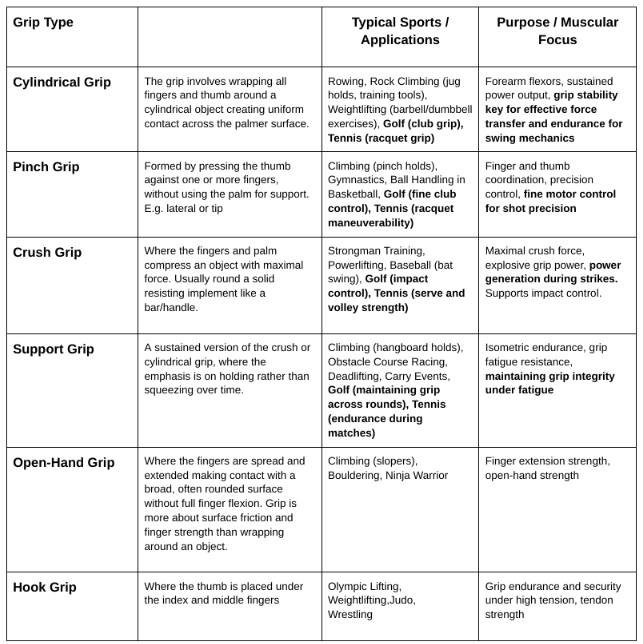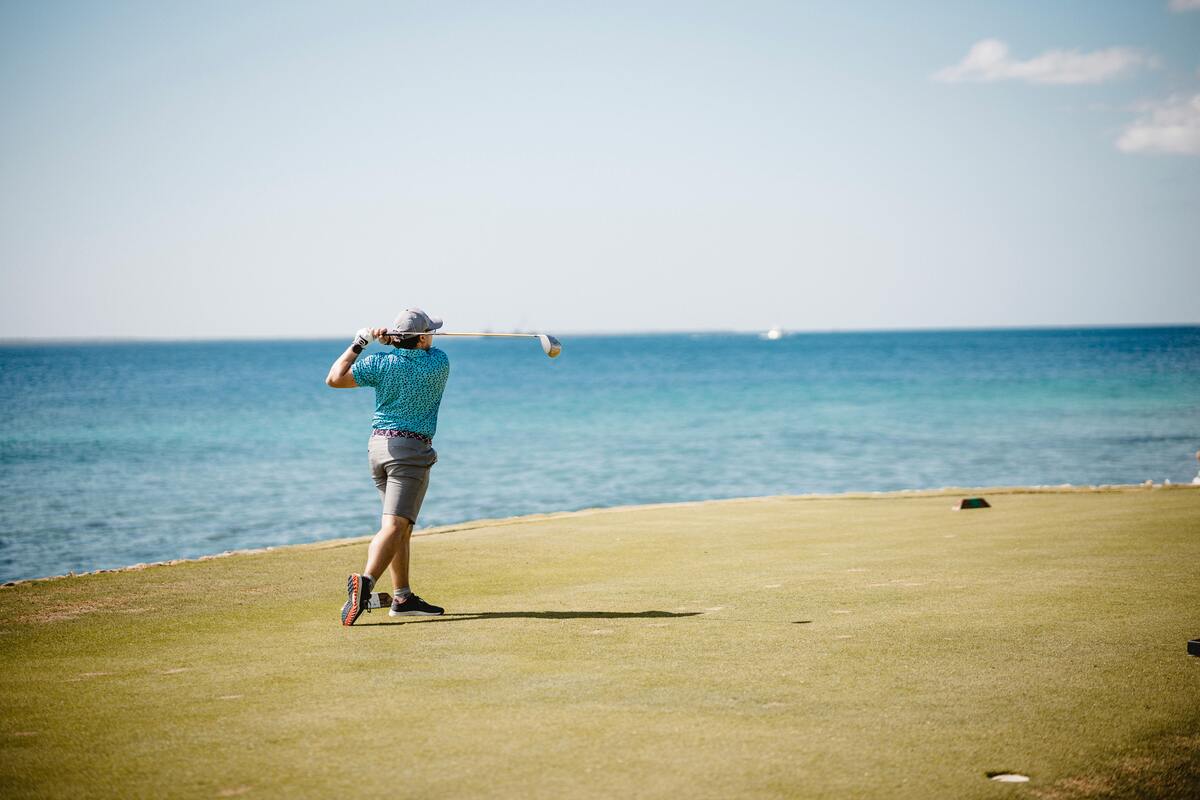Hand grip strength is increasingly recognized as an indispensable biomarker of functional health and performance. In this article, we explore the connection between grip strength and sport performance.
By integrating grip strength assessment into sports protocols, teams can unlock fast, objective insights into readiness, track fatigue and recovery, and support long-term athletic development planning.
For elite athletes, 1% performance gains are game-changing, and Able Assess supports these marginal gains through data-driven insights into performance and recovery.
Grip Strength and Performance Optimization by Sport
Hand-to-Equipment e.g. Golf, Baseball, Tennis, Weightlifting
- Grip strength is essential for effective power transfer and equipment control.
- Grip strength correlates strongly with rotational force, swing velocity (bat/club speed), and shot velocity, especially in power-oriented sports.
- It helps establish a baseline for power output, which, when combined with assessments of skill, neuromuscular coordination, and timing, can support targeted performance improvements.
Key takeaway: Measure grip strength for baseline or general strength profiling (in sports where power output and grip fatigue are factors). Grip strength is less predictive of fine motor actions such as precision or accuracy.
Examples:
In tennis, dominant hand grip strength strongly correlates with serve velocity (r ≈ 0.71; Bilic et al 2024). Maximal grip force is also strongly associated with flat serve speed in elite junior players (r = 0.88; Fernandez-Fernande et al 2014).
Hand-to-Hand Combat e.g. Wrestling, Judo, MMA, Jiu-Jitsu
- Grip strength and grip endurance are strong predictors of performance.
- Validated sport-specific protocols exist (e.g. gripping a judogi sleeve).
- Elite athletes show significantly higher hand grip strength vs sub-elite.
Key takeaway: Use grip strength measurements to track fatigue and prevent injury.
Examples:
Judo medalists recovered grip strength faster between matches than non-medalists (Kons 2018).
Significant differences in grip strength across weight classes led to creation of judo-specific classification tables (Franchini et al 2018).
Hand-to-Fixed Apparatus e.g. Climbing, Gymnastics
- Strong correlations between relative hand grip strength and climbing ability (r = 0.55-0.94).
- Grip endurance is key in these sports
- Large effect sizes noted between elite and sub-elite climbers; female athletes show especially strong associations
Key takeaway: Measure relative grip strength and/or develop sport-specific protocols (for example adapting the position of the body arm to reflect the sport in a repeatable way) to improve grip strength and grip endurance testing.
Example:
Recreational climbers outperform non-climbers in 6 out of 7 grip tests, with more balanced grip strength between hands (Assmann et al 2020)
Hand-to-Projectile e.g. Rugby, AFL, Baseball throwing, Discus
- Grip strength shows moderate correlation to throwing velocity and shot power, especially in youth and less trained athletes, or return-to-play settings.
Key takeaway: Measure grip strength as a supporting metric for throwing power, as part of a broader kinetic chain, especially for monitoring upper body strength or in rehab/training settings.
Examples:
Youth rugby academy players shows significantly greater grip strength than non-selectees (d ≈ 0.5; Diamondo et al’s 2021).
In elite water polo, maximal grip strength was shown to correlate with throwing velocity (r ≈ 0.60; Ferragut et al 2011).
Explosive Power e.g. sprinting, jumping, and Olympic lifting
- Higher grip strength is shown to correlate with peak power output and overall neuromuscular capacity, key components of success in explosive disciplines.
- For sports disciplines where the role of the hand is less performance critical, grip strength still holds value, not as a direct measure of sport specific function but serving as a proxy for whole body muscle strength.
Key takeaway: Grip strength can gauge peak power potential and to monitor neuromuscular readiness in high intensity, performance driven sport.
Examples:
In weightlifting, athletes need grip strength that never fails under load, typically requiring the ability to hold well over their bodyweight; at the elite level, grip strength is rarely the limiting factor (Cronin et al 2017).
Grip Strength for Performance Optimization
Grip Strength is a powerful tool that supports precision, control and confidence across a wide range of sports.
Most sports call on multiple grip styles, not just one, and being able to switch between them with ease is a mark of athletic skill.
A climber might need the dynamic power of a crush grip one moment and the subtle control of an open hand grip the next.
Understanding and training these different grip types helps athletes unlock better performance, build endurance and reduce the risk of injury.
It’s not just about strength, it’s about versatility and control, and Able Assess can be adapted and modified to support data insights.

Data-driven training: How to measure grip strength in sport
- Incorporate grip strength into your sports performance program to enhance assessments, scalability and relevance across disciplines. Sport specific grip strength protocols can be adapted to align with the biomechanical demands of each discipline (arm position, posture and grip patterns, ensuring relevance and ecological validity).
- Protocol standardization: use consistent testing conditions (same time of day, pre/post training, warm-up, and dyanomometer type).
- Set individual athlete baselines to track improvements or declines. Personalized strength programs can be designed based on grip strength trends.
- Monitoring asymmetries: identifying left-right hand strength imbalances can highlight compensatory injury risk
- Integrate results into coaching decisions (adjust training loads based on readiness).
- Combine grip strength with other performance metrics: Layer grip strength data with, for example, VO2MAX, HRV, sleep, RPE, and force plate outputs for a more holistic picture of athlete performance.
- Device affordability, sensitivity and reliability: Grip strength measuring devices must be portable, cost-effective, and capable of detecting subtle performance changes with reliable, repeatable results, plus visible performance trends over time- supporting timely decision making.
Read our Hand Dynamometer Guide for more information.
Able Assess: The only grip strength platform equipped for data-driven elite and amateur athletes
Able Assess turns grip strength into a powerful digital endpoint.
The GripAble dynamometer has a contoured cylindrical shape which encourages a functional grip pattern, making it intuitive for many different uses while closely mirroring sport relevant grip mechanics.
This, enables fast, standardized sensitive testing, delivering data-driven insights to support athlete monitoring, training, rehab, and performance analysis:
- Remote Baseline & Recovery Tracking: Monitor grip strength over time whether in the gym or on the field to track progress, detect plateaus, and assess training effectiveness through longitudinal data.
- Sport-Specific Protocol Customization: tailor Able Assess to the sport and athlete population, using the most appropriate grip and position to reflect the demands of the sport.
- Live Normative Data Comparison: the most modern and up-to-date UK and US based normative dataset for elite sport-specific benchmarking
For further reading about Able Assess, explore our extensive collection of studies on using a hand dynamometer, grip strength and more here, including:
- Grip Strength and Longevity: The New Essential Biomarker
- Grip Strength and Surgery: The New Essential Biomarker
- Grip Strength and Respiratory Disease: The New Essential Biomarker
- Grip Strength and Oncology: The New Essential Biomarker
- Grip Strength and Renal Disease: The New Essential Biomarker
- Grip Strength and Gastrointestinal Disease: The New Essential Biomarker
- Grip Strength and Frailty: The New Essential Biomarker
- Grip Strength and Heart Disease: The New Essential Biomarker
- What are Biomarkers? The Role of Grip Strength in Modern Healthcare
- Hand Dynamometer Guide: The Essentials
- Able Assess User Guide
About us: Able Care
Able Care is a pioneering functional health company. We leverage our proprietary GripAble sensor and advanced data platform to integrate grip strength into routine medical practice, health and wellness and sport performance.
Able Assess brings grip strength metric into real-world training, and research environments, redefining how to measure and manage strength and recovery.
Grip strength is a window into overall athletic capacity, readiness, and resilience. Make it part of your performance strategy.
Please don’t hesitate to get in touch with us at hello@able-care.co or contact us for more information.

